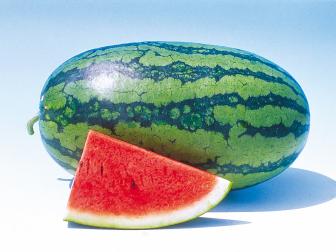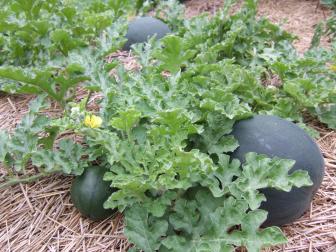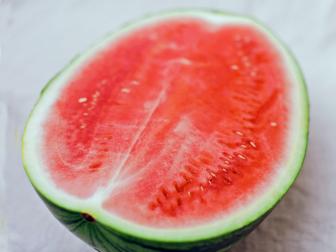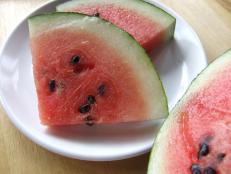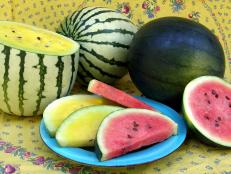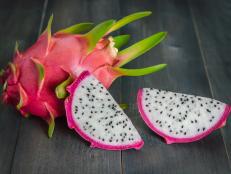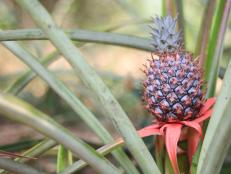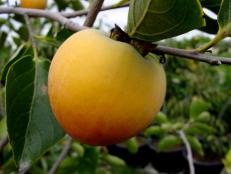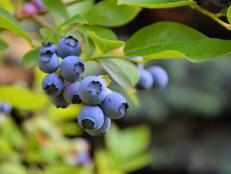How to Plant and Grow Watermelon
These sweet summer treats are easy to grow. All you need is a seed, sun, heat and water.
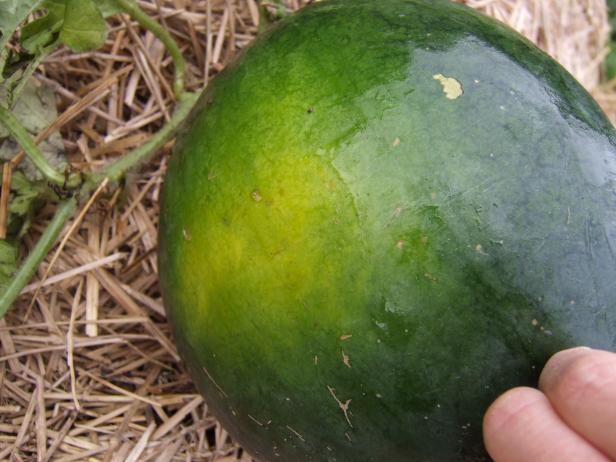
Julie Martens Forney
A sign of a ripe watermelon is when the ground spot—the part of the melon resting on the ground—turns from bright white to yellow. This ground spot is not fully yellow. You can still see green streaks in the yellow field, a sure sign that the watermelon is not ripe.

To taste a watermelon is to know “what angels eat,” Mark Twain said. Watermelons range from single serving types to mammoth melons that can feed an entire soccer team. Here's how to plant, grow and care for watermelons so you can grow a bite of heaven in your garden.
Watermelon History and Facts
The watermelon's heavenly taste originated almost 5,000 years ago in Africa. Hieroglyphics on the walls of ancient Egyptian buildings tell of watermelon harvests, and watermelons were buried with pharaohs so they would have fruit in the afterlife.
There were watermelon seeds in King Tut's tomb. Watermelons spread across the Mediterranean into Europe by the 13th century, and they were in Massachusetts with the Pilgrims in 1629.
Today, more than 1,200 varieties of watermelons are grown in 96 countries around the world. They're a big commercial crop in the Southern U.S., where summers are long and hot, and the soil is sandy.
Botanical Name: Citrullus lanatus
Common Names: Watermelon
Hardiness Zones: 3 to 11
Health Benefits of Watermelon
Don't let a few seeds get in the way of you and good health.
Planting a Watermelon
It takes 70 to 100 days for a seed to grow into a melon that's ready to eat, so how and when to plant a melon depends on where you live.
- If your growing season is short, start seeds indoors about three weeks before your last frost date in the spring. Transplant them into your garden once all danger of a freeze has passed.
- If you live in a warmer climate, sow seeds directly into the ground after your area's last frost date.
- Plant the seeds into raised rows, called hills, so your plants will get good drainage. Space plants about 2 feet apart in a 5-foot-wide hill. If you're planting in rows, leave 6 feet between the rows. Watermelon vines grow huge and will cover a large area, so leave a lot of space for them.
- Watermelons like loose, well-drained soil that has been enriched with aged manure or compost before planting. They're heavy feeders, so they need soil that can supply the vines with nutrients. If your soil is too poor, the melons won't be as sweet. The soil pH should be 6 to 6.8.
Companion Planting for Watermelon
Grow a better crop of watermelon by trying out companion planting techniques such as growing trap crops to keep pests away from your watermelon vines.
Caring for a Watermelon Plant
- Mulch your plants to keep weeds down and hold moisture in the soil.
- Melons need a lot of water – 1" to 2" per week – while they're growing, blooming and setting fruit. Keep the soil moist but not soggy. Water at the vine base in the early morning. Avoid wetting leaves or you may cause leaf fungus or powdery mildew.
- Vines produce male and female flowers on the same plant. Don't be worried if the male flowers fall off; the female flowers will stay on the vine and turn into fruit.
- Cut water in half once the melon is growing. While watermelon plants need lots of water, too much water can result in tasteless fruit. Be generous during the growing cycle, but pull back on the amount you give just before the fruit begins to ripen and then stop altogether right before harvesting.
- As the fruit is ripening, keep it from rotting by gently lifting up the melon and placing straw or cardboard between the fruit and the soil.
Pests and Diseases
- Cucumber beetles: Consider growing trap crops ‘Blue Hubbard’ squash to lure pests such as squash bugs and cucumber beetles away from watermelon vines.
- Vine borers
- Fusarium wilt: Avoid planting in soils with a history of the disease.
- Aphids: Remove with a soap solution.
- Deer or coyote could become bothersome. Keep away with fencing if you notice a problem.
Harvesting Watermelon
The trick to harvesting a watermelon is figuring out when it's ripe.
How to To Tell When a Watermelon is Ripe
Here are the signs a melon is ready to pick:
- The spot on the underside of the melon where it has been sitting on the ground is pale to rich yellow. (It's green or pale white when it's not ripe.)
- The green, curling tendrils at the stem start to dry out and turn brown.
- The melon's surface is dull, not shiny.
- This may be more art than science, but some gardeners tap each melon and listen for the sound it makes. A hollow-sounding fruit is ripe and a tinny-sounding fruit is unripe.
Cut the stem close to the melon with a sharp knife.
Storing Watermelons
At room temperature, uncut watermelons will keep for up to 10 days. Shelf life may be shorter if the watermelon is exposed to ethylene gas producing fruit such as apples, stone fruits and grapes. Whole watermelons stored below 60 degrees will stay fresh for about two weeks.
Don't store cut watermelon at room temperature. Try to use cut watermelon the day after storing in a refrigerator, but if tightly wrapped, cut wamermelons can be refrigerated for up to three days. Watermelon can be frozen in cubes or chunks. Here's how to freeze watermelon.
For best taste, cool a whole watermelon in the refrigerator before cutting.
Can You Freeze Watermelon?
Leftover watermelon doesn't have to spoil. Preserve the excess in the freezer for a summery treat this winter. .
11 Popular Varieties
‘Black Diamond’ watermelons are huge, often weighing 50 pounds or more when harvested. This heirloom has a dark, nearly black exterior and bright red interior, making for striking watermelon slices. It requires a long growing season, 90+ days to maturity.
‘Charleston Gray’ dates back to the 1950s and is a beloved variety throughout the Southeast. Oblong fruits weigh 25+ pounds; inside, the pink flesh is deliciously sweet.
‘Congo’ was an All-America Selections Winner way back in 1950, and this heirloom has been a favorite for gardeners ever since. Fruits are oblong-shaped, weigh 30+ pounds, and are known to taste super-sweet.
‘Crimson Sweet’ is best known for its incredible sweetness, coming from a higher-than-normal sugar content. The heirloom’s striped green exterior has a classic watermelon look, and fruit typically reach 25 pounds.
'Georgia Rattlesnake Melon' is the classic, 2-foot long Southern watermelon with pale green stripes that weighs up to 35 pounds. It's an heirloom, developed in its namesake state in the 1830s.
'Harvest Moon' is a hybridized version of the heirloom 'Moon and Stars' that's seedless and has shorter vines.
‘Jubilee’ was developed by the University of Florida in 1963 and is well-known for its oblong shape and large size, with fruits up to 40 pounds. The more recent ‘Jubilee Improved’ variety has more resistance to fusarium wilt and anthracnose.
'Moon and Stars' is an heirloom in introduced in the 1920s that has a deep green skin speckled with yellow specks that look like tiny stars and moons. Melons average 25 pounds.
'Sweet Beauty' bears little 6-pound melons so another good choice for a small garden.
'Sugar Baby' produces an icebox-sized melon that weighs 8 to 10 pounds so it's a good choice for small gardens. It's a good choice for areas with short growing seasons, too, since it matures in just 75 days.
'Yellow Baby' has small, 6-pound fruits with sweet yellow flesh and matures early, usually in 70-75 days.
Winning Watermelon Recipes
Savor summer with a watermelon margarita and a melon salsa.
Watermelon Recipes from Food Network
Get Food Network's best watermelon salad recipes that will complete every summer meal and highlight your cookouts.






